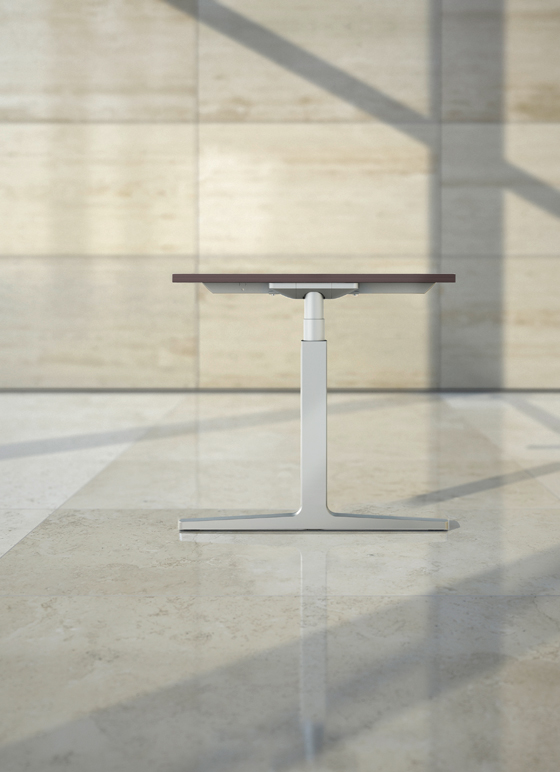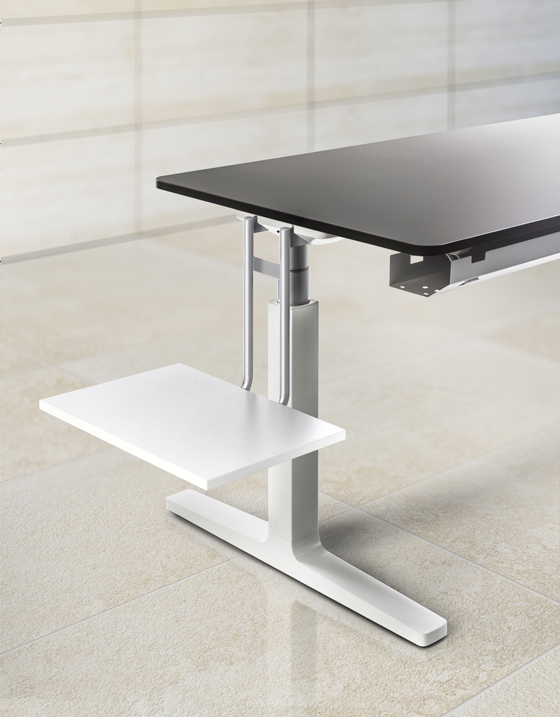The CHANGE Table System by VARIO
Storia del Marchio di Ulrich Büttner
Liederbach am Taunus, Germania
15.10.14
CHANGE represents a new generation of adjustable-height office desks and conference tables whose development has emphasized exemplary functionality, versatility and, most notably, a focus on design.
The side view of CHANGE’S T-foot model gives no indication that its height is adjustable
Does anyone remember the days when an office table was just a simple framework with a top and four legs? One height was available, and choice was limited to different styles of tabletops. That was acceptable for about two-thirds of the office staff. Their colleagues, however, had to make do by adjusting the height of their swivel chairs, which was inconvenient and often detrimental to health. Then the idea for an adjustable-height table came our way from Scandinavia.
Ergonomics – the magic word when it came to progress regarding office furniture, even early on – was applied to the development of tables and desks. Adjustable-height tables are useful for anyone of any size; consequently, most manufacturers of office desks now have one or more models in their product range. But some worktables have risen to dizzying heights as sitting, especially in the office, has fallen into disrepute and the practice of standing while working has increased.
No longitudinal crossbar obstructs the legroom. The construction transmits all the loads effectively and gracefully to the bottom runners
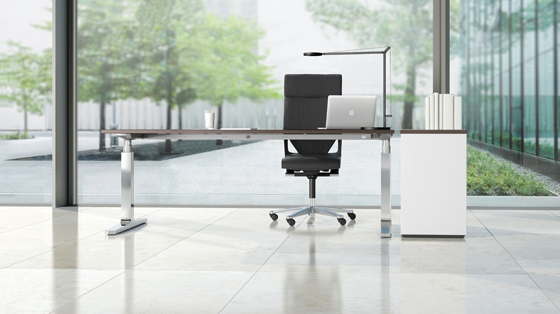
No longitudinal crossbar obstructs the legroom. The construction transmits all the loads effectively and gracefully to the bottom runners
×Against this backdrop, the announcement by furniture manufacturer VARIO – that they have developed a new generation of adjustable-height desks and conference tables – can be seen as a challenge to the homogeneity of design in today’s market. Managing Director Matthias Kurreck sums up the initial objective: ‘We wanted to develop a sit/stand table which would not just make an impact on the market with regard to its quality but also and above all with respect to functionality, weight, design and individuality.’
The goal is to promote the well-being of people working in the modern office environment. The latest developments in ergonomics and functionality are translated into a formally sophisticated product, offering a desirable and ergonomic means for height adjustment of the work surface in compliance with standards, and doing so in a way that is suitable for daily use, uncomplicated and motivating a shift to healthier work habits. Only a system that inspires confidence and bespeaks reliability can convince users to accept the opportunity to convert their regular desks, even part of the time, into standing workstations with their recognized ergonomic advantages.
CHANGE allows for all the proven desk and table configurations used in modern office concepts
But what about the design? That’s the first thing you notice. Design and ergonomics are neither intrinsically nor often successfully paired. In making adjustable-height tables, much steel was and is commonly used – for runners, columns, crossbars and beams – to ensure stability. This often results in unattractive profiles, substantial weight, a need to employ real powerhouses for motorized raising and lowering, and a certain amount of hassle when manually adjusting the height. These problems do not exist in the ‘lightweight’ league, but then the table clatters or wobbles, and even after years of operation, the little squeaky crank handle beneath the front of the table still fights for the user’s trust.
VARIO has once again evidenced its know-how, its feel for innovation and its diligence in solving important construction and design details. After a scant two-year development period, the successful collaboration with designers Uwe Sommerlade and Gerhard Bernhold yielded a no-nonsense, elegant series of sit/stand tables that display a reserved appearance while retaining a sense of individuality. CHANGE complements the existing product range and underscores the company’s strategy of assigning a key role to design in the development of furniture series.
The control element for electromotive height adjustment from 65 to 130 cm not only adjusts the height to match various users’ needs but also enables ‘transformation’ into a standing table

The control element for electromotive height adjustment from 65 to 130 cm not only adjusts the height to match various users’ needs but also enables ‘transformation’ into a standing table
×Cables run through a vertical cableway mounted to the leg without tools and then via a cable chain to a fold-down cable tray beneath the front edge of the table
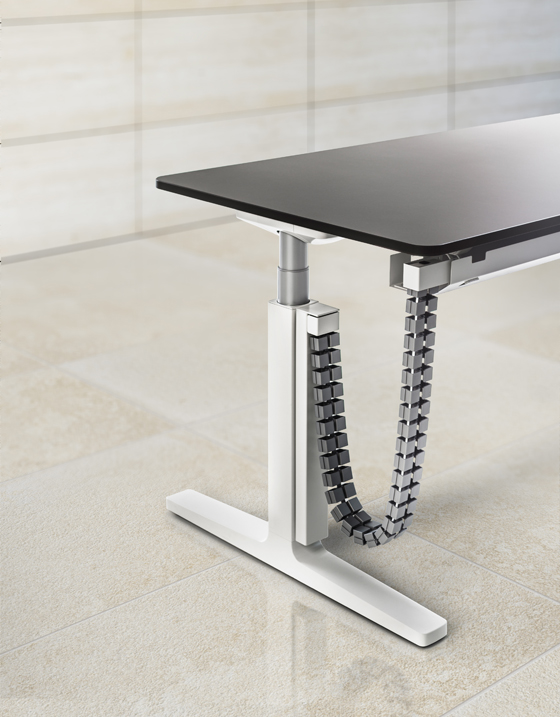
Cables run through a vertical cableway mounted to the leg without tools and then via a cable chain to a fold-down cable tray beneath the front edge of the table
×The decision to draw upon skillful support from external designers did not mean excluding the involvement of VARIO’s own development department. Many details and components evolved in close cooperation. CHANGE offers both T- and C-feet, which is nothing special. But in this case, both variants are very similar in formal terms. That pleases both architects and office planners, who are otherwise usually confronted with a design problem when they seek to use both types in the same room. But not here. Certain configurations, such as corner desks, can be realized better – more ergonomically – with the asymmetric C-foot; but the T-foot is preferred by planners for its symmetry. By harmonizing the formal characteristics of both types, this table system overcomes the prevalent ‘incompatibility’ of components within other product lines on the market.
Although standing is preferable for short meetings and informal gatherings, not much will be achieved in terms of flexibility until it is customary for individual and even grouped conference tables to be adjusted in height as easily as work desks. CHANGE’s configurability is as natural as the positive feel of the entire space within reach of the user. Curvatures, radiuses, edges, surface properties – everything is implemented with high standards. Last but not least, the considerable selection of surfaces and colours, offering manifold combinations for any interior concept, acknowledges the growing demand for the individualisation of industrial products.
Bottom view with sliding tabletop locking assembly, equipment racks to the side and, beneath the table, cable tray and privacy screen. The primary stabilising structure includes the table legs, the longitudinal beam, and two tabletop mounting rails
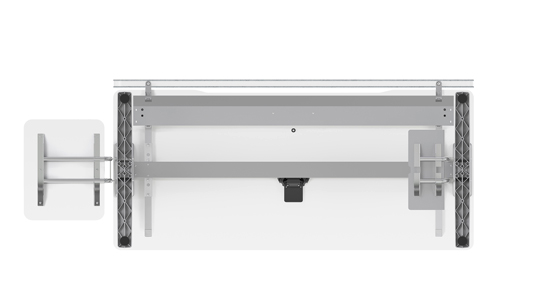
Bottom view with sliding tabletop locking assembly, equipment racks to the side and, beneath the table, cable tray and privacy screen. The primary stabilising structure includes the table legs, the longitudinal beam, and two tabletop mounting rails
×An essential prerequisite for such an advanced design concept was the decision by VARIO’s management to not limit the expected tooling costs at the outset. ‘They granted us designers optimum freedom,’ recalls Uwe Sommerlade, who considers CHANGE to be an independently designed product line, not simply a standardised mechanized table. At any rate, there is hardly anything like it currently on the market, and being awarded the Red Dot Design Award 2014 gives due respect to all those involved in its development.
The runner is of die-cast aluminum and the outer leg column of extruded aluminum. Although both components are basically square-shaped, they have slightly curved surfaces; and even though they join at a 90-degree angle, their transition is so visually organic that the table foot seems to be one piece. In actuality, they join above the curved arc of the bottom runner. The decision to make the runner and outer leg of aluminum increases creative opportunities and design freedom while also significantly reducing weight. A major difference from other products is that the essential telescopic supporting column does not automatically become a ‘supporting’ part in terms of design, nor is it simply obscured or embellished. The round, two- or three-part telescopic column is located within the outer leg column of CHANGE. Height adjustments can be made manually without tools in centimeter increments from 65 to 85 cm or, with the aid of an electric motor, continuously from 65 to 130 cm. The elegant column head – the manufacturer calls it a connecting element – is an elongated, relatively flat molded component that highlights the flush positioning of the leg construction at the sides. Three plastic caps cover its inner workings. Since CHANGE does not have the usual crossbar at knee height, the table system affords maximum legroom – and the transmission of forces between the telescopic column and longitudinal beam beneath the tabletop, which are joined by the connecting element, is of central importance. The potential bending forces are considerable, especially when the columns are fully extended, but little deformation occurs as they are conducted into the columns and bottom runners. Nothing wobbles. The only audible sound comes from the quiet electric drive, which, when needed, operates unseen within the columns. The nearly invisible structure is completed by two mounting rails, which are perpendicular to the longitudinal beam, next to the connecting elements. These rails are recessed, thus lying almost in the plane of the longitudinal beam.
Holders for printers or computers can be suspended from the connecting elements, either beneath the work surface or off to the side, with a maximum of two per table
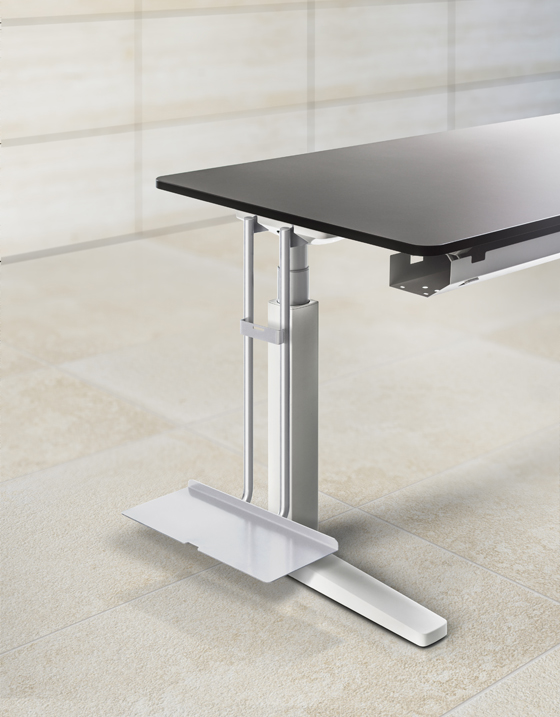
Holders for printers or computers can be suspended from the connecting elements, either beneath the work surface or off to the side, with a maximum of two per table
×CHANGE is available with the usual tabletop sizes and shapes as well as free-form tabletops, all made of HPL or fiberboard. The choice between tabletop corners that are either squared off or rounded with a 40 mm radius can strongly influence the character of an entire arrangement of tables. The patented sliding tabletop locking assembly is the leading feature among the numerous intelligently designed details. Sliding tabletops facilitate access to the horizontal cable tray when the tables are fitted with certain optional features and also in some table configurations. Adjustable-height tables with sloppy cable routing are an eyesore, and not just for architects. Here they are kept tidy, fed through a cableway to the top of the table foot and then through a flexible cable chain. The diverse privacy screens and modesty panels with corresponding shelves and holders, together with equipment racks for computers and printers, present a unified appearance. Optional connecting rails between the legs of adjacent tables also allow privacy screens to be fixed in a uniform position independent of the changing heights of the tabletops. That is important, for example, if freestanding screens cannot be used due to ventilation concerns.
CHANGE is suitable for a wide variety of table and desk configurations and for all common office configurations. Entirely different areas of application can be taken into account and represented – from executive management offices and demanding individual workstations to process-optimized open plan offices – without having to compromise in terms of design quality, functionality, flexibility or ergonomics. Architects and project planners particularly appreciate the formal integration of solutions for conference rooms and meeting areas which the CHANGE table system offers: its individual meeting tables and grouped tables are equipped with the same features for height adjustment as are the desks.
The essentials at a glance: a flat connecting element joins the longitudinal beam and telescopic column into a rigid frame that securely directs all forces into the table foot
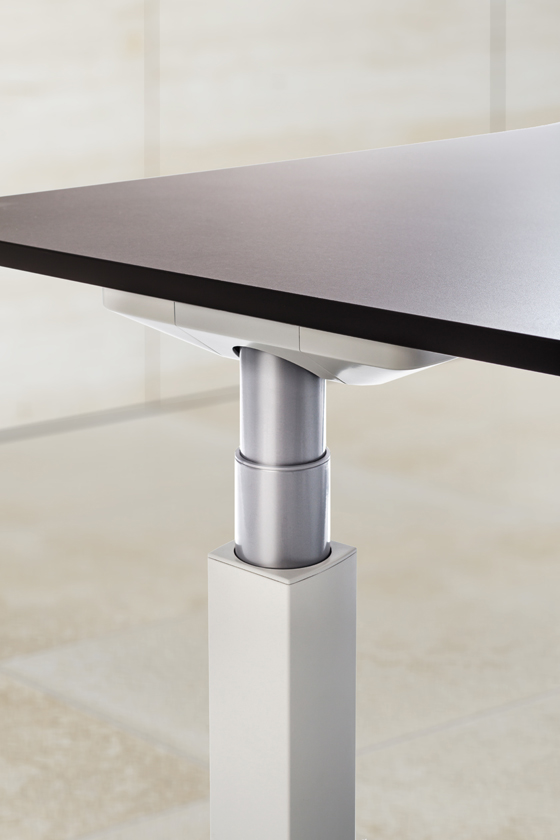
The essentials at a glance: a flat connecting element joins the longitudinal beam and telescopic column into a rigid frame that securely directs all forces into the table foot
×Once all requirements are resolved in terms of function and ergonomics, and if the overall appearance, construction and details are compelling, the last remaining important decision concerns surface finishes and colors. The range of choices for the tabletop and frame of CHANGE is lavish. For decorative laminate alone, there are eight wood grain patterns and six solid colours; and there are also eight wood veneers, three colours for HPL solid core tops, and four desktop linoleum colours to choose from. For the frames, which include the runners, outer columns, telescopic inner columns, and column heads, five harmonious combinations are offered from four basic colours: premium white, white aluminum, porcelain and chrome.
The clear formal language of CHANGE also accommodates combinations with established storage space and partition systems from VARIO’s current collection.

